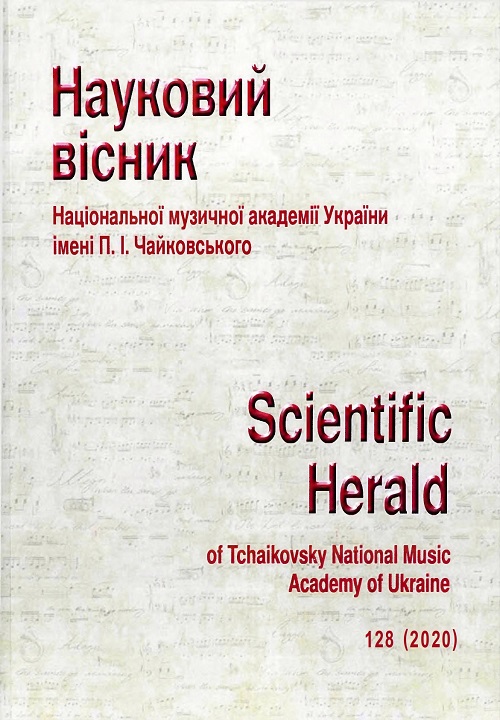Sound as a Style Somponent of Art Rock: Formation Ways and Factors
DOI:
https://doi.org/10.31318/2522-4190.2020.128.215191Keywords:
sound, art rock, progressive rock, timbre, textureAbstract
Relevance of research. Recent studies of rock music by representatives of academic musicology are more and more often devoted to matters of style. An important component of rock stylistics is sound that is first of all related to timbre coloristic and texture characteristics of sounding. It is the sound that highlights the creative individuality of rock musicians and becomes a key to support rock bands awareness. Sound obtains a special value in the creative practice of art rock (including progressive rock) that is an intersection of rock and academic music. This is why the studies of sound formation factors are important, both merely artistic and those beyond artistic.
Main objective of the study. The purpose of the article is through the example of creative work of rock bands that are the main art rock representatives (“Genesis”, “Gentle Giant”, “King Crimson”, “Pink Floyd”, “Yes”) define the ways and different in nature factors of sound formation process. The research methods. The choice of research methods is determined by specificity of material, namely by the fact that the musical notation of the music being analyzed is not available. The main in the study is the comparative method that allows us to clarify common displays and difference in sound formation or art rock bands, as well as respectively modified intonational analysis methods.
Results and conclusions. Sound arises as a style category that defines individual character of sounding. The creative practice of rock music typically involves unity of the author(s) of the music and the performer(s), therefore rock music is considered as a result of combination of the composer’s and the performer’s intentions in the artistic communication. The ensemble specificity of rock bands requires special attention to the nature of relation of vocal and instrumental components and the analysis of their importance in the sound formation of one or another band. Consideration of sound in the context of timbre and timbre formation allowed to state the spread in the practice of art rock of trends that previously formed in the field of academic music of the 20th century: significant expansion of instruments, use of noise and specific sounds, rethinking the possibilities of various instruments, experiments with musical texture.
A special role of music producers, arrangers and sound directors in the sound formation has been noted. It is emphasized that the search for new sounds stimulated the design of fundamentally new electromechanical (such as Mellotron) and electronic instruments. It is shown with the example of specific groups that the formation of sound in art rock is often the result of inter-genre and stylistic synthesis, when distant genre-style layers become material for textural, dynamic, agogical experiments. It is claimed that further research into the sound will provide an opportunity to get closer to understanding the mechanisms of style formation in rock music.
References
Vavshko, I. V. (2019). Musical poetics of rock-ballad [Muzychna poetyka rok-ballad]. Manuscript of Dissertation work for gaining the degree of the Candidate of Art Criticism by specialty 17.00.03 Music Art. Tchaikovsky National Music Academy of Ukraine, Ministry of Culture of Ukraine, Kyiv, 214 р. [in Ukraine].
Manafova, М. М. (2011).Timbre-coloristic properties of orchestral fabric in music of the second half of the 20th century: on the example of E. Denisov’s work [Tembrokoloristscheskie svoystva orkestrovoy tkani v muzyke vtoroy poloviny XX veka: na primere tvorchestva E. Denisova]. The dissertation author’s abstract for gaining the degree of the Candidate of Art Criticism by specialty 17.00.02 Music Art. N. A. Rimsky-Korsakov Saint Petersburg State Conservatory. SaintPetersburg, 22 р. [in Russian].
Ozerov, V. (1984). Glossary of specific terms [Slovar’ spetsial’nykh terminov]. Collier J. The Making of Jazz [Stanovlenie dzhaza], transl. from English. Moscow : Raduga, рр. 357–376 [in Russian].
Savytskaya, E. A. (1999). Principles of style synthesis of rock-music (as exemplified in foreign hard- and art-rock of 60–70-s.). [Printsipy stileobrazovaniya v rok-muzyke (na materiale zarubezhnogo khard- i art-roka 60–70-kh godov)]. Manuscript of Dissertation work for gaining the degree of the Candidate of Art Criticism by specialty 17.00.03 Music Art.. State Institute of Art Studies. Moskow, 282 p. [in Russian].
Syrov, V. (2008). Style metamorphoses of rock [Stilevye metamorfozy roka]. SaintPetersburg : Kompozytor Sankt-Peterburh, 312 p. [in Russian].
Wald, E. (2018). How the Beatles Destroyed Rock ’n’ Roll: An Alternative History of American Popular Music [Kak The Beatles unichtozhili rok-n-roll. Al’ternativnaya istoriya amerikanskoy populyarnoy muzyki], transl. from English. Moscow, 448 р. [in Russian].
Anderton, C. (2019). Introduction to the Special Issue on Progressive Rock. Prepublication draft of Rock Music Studies. 7 (1): 1–7 (2020). Available at: https://www.researchgate.net/publication/334993605_Introduction_to_the_Special_Issue_on_Progr essive_Rock (accessed: 29.05.2020) [in English].
Dye, D. (2007). Sir George Martin Talks “Love” On World Café. National Public Radio. February 19, 2007 (aired on Dec. 22, 2006). Available at: https://www.npr.org/sections/world-cafe /2007/02/19/6665771/george-martin-the-fifth-beatle-returns (accessed: 20.05.2020) [in English].
Kopp, B. (2011). Interview: Steven Wilson on the King Crimson 40th Anniversary Reissue Project. Musoscribe: Bill Kopp’s Music Magazine. January 24. Available at: http://blog.musoscribe.com/index.php/2011/01/24/interview-steven-wilson-on-the-king-crimson40th-anniversary-reissue-project/ (accessed: 12.05.2020) [in English].
Obituary: Sir George Martin. 9 March 2016 Available at: https://www.bbc.com/news/entertainment-arts-20449870 (accessed: 20.05.2020) [in English].
Stakes, R. (2001). These boys: the rise of Mersey beat. Gladsongs and Gatherings: Poetry and its Social Context in Liverpool Since the 1960s. Liverpool : Liverpool University Press, рр. 157–166 [in English].
The Man Who Would Be King. An Interview With Jonathan King. Available at: http://www.worldofgenesis.com/JonathanKing-Interview.htm (accessed: 05.05. 2020) [in English].
Welch, С. (1976). Genesis Re-born. Melody Maker. 7th February [in English].


